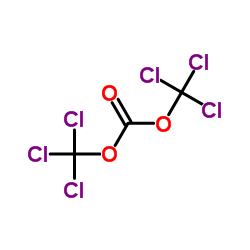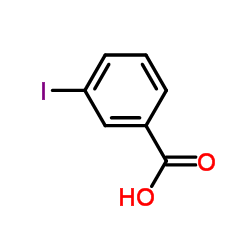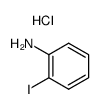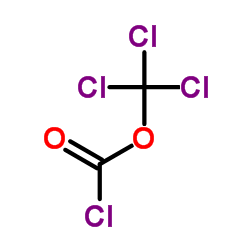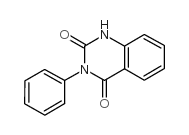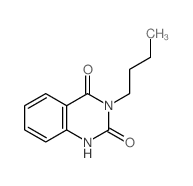128255-31-2
| Name | 1-iodo-2-isocyanatobenzene |
|---|---|
| Synonyms |
2-Iodophenyl isocyanate
o-iodophenylisocyanate Benzene,1-iodo-2-isocyanato 1-iodo-2-isocyanato-benzene MFCD00673044 |
| Density | 1.891 g/mL at 25 °C(lit.) |
|---|---|
| Boiling Point | 245 °C(lit.) |
| Molecular Formula | C7H4INO |
| Molecular Weight | 245.01700 |
| Flash Point | >230 °F |
| Exact Mass | 244.93400 |
| PSA | 29.43000 |
| LogP | 2.25850 |
| Vapour Pressure | 0.0238mmHg at 25°C |
| Index of Refraction | n20/D 1.633(lit.) |
| Storage condition | ?20°C |
Synonym:None Section 2 - COMPOSITION, INFORMATION ON INGREDIENTS
Risk Phrases: 20/21/22 Section 3 - HAZARDS IDENTIFICATION EMERGENCY OVERVIEW
Harmful by inhalation, in contact with skin and if swallowed.The toxicological properties of this material have not been fully investigated. Potential Health Effects Eye: May cause eye irritation. The toxicological properties of this material have not been fully investigated. Skin: May cause skin irritation. The toxicological properties of this material have not been fully investigated. Ingestion: May cause gastrointestinal irritation with nausea, vomiting and diarrhea. May cause liver and kidney damage. May cause cardiac disturbances. The toxicological properties of this substance have not been fully investigated. May cause central nervous system depression. Inhalation: May cause respiratory tract irritation. May cause liver and kidney damage. May cause heart disturbances, possibly leading to cardiac arrest and death. The toxicological properties of this substance have not been fully investigated. Exposure produces central nervous system depression. Chronic: May cause liver and kidney damage. Section 4 - FIRST AID MEASURES Eyes: Flush eyes with plenty of water for at least 15 minutes, occasionally lifting the upper and lower eyelids. Get medical aid immediately. Skin: Get medical aid. Flush skin with plenty of water for at least 15 minutes while removing contaminated clothing and shoes. Wash clothing before reuse. Ingestion: If victim is conscious and alert, give 2-4 cupfuls of milk or water. Never give anything by mouth to an unconscious person. Get medical aid immediately. Wash mouth out with water. Inhalation: Get medical aid immediately. Remove from exposure and move to fresh air immediately. If not breathing, give artificial respiration. If breathing is difficult, give oxygen. Do NOT use mouth-to-mouth resuscitation. Notes to Physician: May be partially metabolized to cyanide in the body. Section 5 - FIRE FIGHTING MEASURES General Information: As in any fire, wear a self-contained breathing apparatus in pressure-demand, MSHA/NIOSH (approved or equivalent), and full protective gear. During a fire, irritating and highly toxic gases may be generated by thermal decomposition or combustion. Vapors may be heavier than air. They can spread along the ground and collect in low or confined areas. Extinguishing Media: Use agent most appropriate to extinguish fire. Use water spray, dry chemical, carbon dioxide, or appropriate foam. Section 6 - ACCIDENTAL RELEASE MEASURES General Information: Use proper personal protective equipment as indicated in Section 8. Spills/Leaks: Absorb spill with inert material (e.g. vermiculite, sand or earth), then place in suitable container. Clean up spills immediately, observing precautions in the Protective Equipment section. Provide ventilation. Section 7 - HANDLING and STORAGE Handling: Wash thoroughly after handling. Use with adequate ventilation. Avoid breathing dust, vapor, mist, or gas. Avoid contact with eyes, skin, and clothing. Keep container tightly closed. Avoid ingestion and inhalation. Storage: Store in a tightly closed container. Store in a cool, dry, well-ventilated area away from incompatible substances. Section 8 - EXPOSURE CONTROLS, PERSONAL PROTECTION Engineering Controls: Use adequate ventilation to keep airborne concentrations low. Exposure Limits CAS# 128255-31-2: Personal Protective Equipment Eyes: Wear appropriate protective eyeglasses or chemical safety goggles as described by OSHA's eye and face protection regulations in 29 CFR 1910.133 or European Standard EN166. Skin: Wear appropriate protective gloves to prevent skin exposure. Clothing: Wear appropriate protective clothing to prevent skin exposure. Respirators: Follow the OSHA respirator regulations found in 29 CFR 1910.134 or European Standard EN 149. Use a NIOSH/MSHA or European Standard EN 149 approved respirator if exposure limits are exceeded or if irritation or other symptoms are experienced. Section 9 - PHYSICAL AND CHEMICAL PROPERTIES Physical State: Clear liquid Color: clear almost colorless Odor: Not available. pH: Not available. Vapor Pressure: Not available. Viscosity: Not available. Boiling Point: 62 deg C @ .66mm Hg Freezing/Melting Point: Not available. Autoignition Temperature: Not available. Flash Point: > 230 deg F (> 110.00 deg C) Explosion Limits, lower: N/A Explosion Limits, upper: N/A Decomposition Temperature: Solubility in water: Specific Gravity/Density: Molecular Formula: IC6H4NCO Molecular Weight: 245.02 Section 10 - STABILITY AND REACTIVITY Chemical Stability: Stable at room temperature in closed containers under normal storage and handling conditions. Conditions to Avoid: Incompatible materials, excess heat. Incompatibilities with Other Materials: Oxidizing agents. Hazardous Decomposition Products: Carbon monoxide, oxides of nitrogen, irritating and toxic fumes and gases, carbon dioxide, hydrogen iodide. Hazardous Polymerization: Has not been reported Section 11 - TOXICOLOGICAL INFORMATION RTECS#: CAS# 128255-31-2 unlisted. LD50/LC50: Not available. Carcinogenicity: 2-Iodophenyl Isocyanate - Not listed by ACGIH, IARC, or NTP. Section 12 - ECOLOGICAL INFORMATION Section 13 - DISPOSAL CONSIDERATIONS Dispose of in a manner consistent with federal, state, and local regulations. Section 14 - TRANSPORT INFORMATION IATA Shipping Name: ISOCYANATES, TOXIC, N.O.S.* Hazard Class: 6.1 UN Number: 2206 Packing Group: III IMO Shipping Name: ISOCYANATES, TOXIC, N.O.S. Hazard Class: 6.1 UN Number: 2206 Packing Group: III RID/ADR Shipping Name: ISOCYANATES, TOXIC, N.O.S. Hazard Class: 6.1 UN Number: 2206 Packing group: III Section 15 - REGULATORY INFORMATION European/International Regulations European Labeling in Accordance with EC Directives Hazard Symbols: XN Risk Phrases: R 20/21/22 Harmful by inhalation, in contact with skin and if swallowed. Safety Phrases: S 28A After contact with skin, wash immediately with plenty of water. S 37 Wear suitable gloves. S 37/39 Wear suitable gloves and eye/face protection. S 45 In case of accident or if you feel unwell, seek medical advice immediately (show the label where possible). WGK (Water Danger/Protection) CAS# 128255-31-2: No information available. Canada None of the chemicals in this product are listed on the DSL/NDSL list. CAS# 128255-31-2 is not listed on Canada's Ingredient Disclosure List. US FEDERAL TSCA CAS# 128255-31-2 is not listed on the TSCA inventory. It is for research and development use only. SECTION 16 - ADDITIONAL INFORMATION N/A |
| Symbol |

GHS07 |
|---|---|
| Signal Word | Warning |
| Hazard Statements | H302-H312-H315-H319-H332-H335 |
| Precautionary Statements | P261-P280-P305 + P351 + P338 |
| Personal Protective Equipment | Eyeshields;Faceshields;full-face respirator (US);Gloves;multi-purpose combination respirator cartridge (US);type ABEK (EN14387) respirator filter |
| Hazard Codes | Xn |
| Risk Phrases | R20/21/22 |
| Safety Phrases | S26-S36/37/39 |
| RIDADR | UN 2206 6.1/PG 3 |
| WGK Germany | 3 |
| HS Code | 2929109000 |
|
~98% 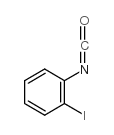
128255-31-2 |
| Literature: Chen, Li; Feng, Lichun; Huang, Mengwei; Li, Jia; Nan, Fajung; Pang, Tao; Yu, Lifang; Zhang, Mei Patent: US2011/71195 A1, 2011 ; Location in patent: Page/Page column 35 ; |
|
~90% 
128255-31-2 |
| Literature: Sashida, Haruki Heterocycles, 1998 , vol. 48, # 4 p. 631 - 634 |
|
~76% 
128255-31-2 |
| Literature: Hays, Sheryl J.; Caprathe, Bradley W.; Gilmore, John L.; Amin, Nilam; Emmerling, Mark R.; Michael, Walter; Nadimpalli, Ravi; Nath, Rathna; Raser, Kadee J.; Stafford, Daniel; Watson, Desiree; Wang, Kevin; Jaen, Juan C. Journal of Medicinal Chemistry, 1998 , vol. 41, # 7 p. 1060 - 1067 |
|
~% 
128255-31-2 |
| Literature: Journal of medicinal chemistry, , vol. 39, # 6 p. 1220 - 1226 |
| Precursor 5 | |
|---|---|
| DownStream 3 | |
| HS Code | 2929109000 |
|---|---|
| Summary | 2929109000. other isocyanates. VAT:17.0%. Tax rebate rate:13.0%. . MFN tariff:6.5%. General tariff:30.0% |
